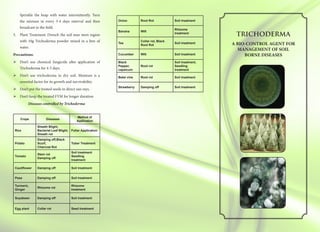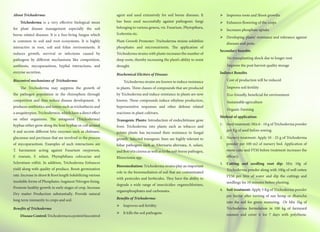trichoderma agriculture related trio.pdf
- 1. TRICHODERMA A BIO-CONTROL AGENT FOR MANAGEMENT OF SOIL BORNE DISEASES Sprinkle the heap with water intermittently. Turn the mixture in every 3-4 days interval and then broadcast in the field. 5. Plant Treatment: Drench the soil near stem region with 10g Trichoderma powder mixed in a litre of water. Precautions: ’āś DonŌĆÖt use chemical fungicide after application of Trichoderma for 4-5 days. ’āś DonŌĆÖt use trichoderma in dry soil. Moisture is a essential factor for its growth and survivability. ’āś DonŌĆÖt put the treated seeds in direct sun rays. ’āś DonŌĆÖt keep the treated FYM for longer duration Diseases controlled by Trichoderma Crops Diseases Method of Application Rice Sheath Blight, Bacterial Leaf Blight, Sheath rot Foliar Application Potato Damping off,Black Scurf, Charcoal Rot Tuber Treatment Tomato Stem rot Damping off Soil treatment Seedling treatment Cauliflower Damping off Soil treatment Peas Damping off Soil treatment Turmeric, Ginger Rhizome rot Rhizome treatment Soyabean Damping off Soil treatment Egg plant Collar rot Seed treatment Onion Root Rot Soil treatment Banana Wilt Rhizome treatment Tea Collar rot, Black Root Rot Soil treatment Cucumber Wilt Soil treatment Black Pepper, capsicum Root rot Soil treatment, Seedling treatment Betel vine Root rot Soil treatment Strawberry Damping off Soil treatment
- 2. About Trichoderma: Trichoderma is a very effective biological mean for plant disease management especially the soil borne related diseases. It is a free-living fungus which is common in soil and root ecosystems. It is highly interactive in root, soil and foliar environments. It reduces growth, survival or infections caused by pathogens by different mechanisms like competition, antibiosis, mycoparasitism, hyphal interactions, and enzyme secretion. Biocontrol mechanisms of Trichoderma: The Trichoderma may suppress the growth of the pathogen population in the rhizosphere through competition and thus reduce disease development. It produces antibiotics and toxins such as trichothecin and a sesquiterpine, Trichodermin, which have a direct effect on other organisms. The antagonist (Trichoderma) hyphae either grow along the host hyphae or coil around it and secrete different lytic enzymes such as chitinase, glucanase and pectinase that are involved in the process of mycoparasitism. Examples of such interactions are T. harzianum acting against Fusarium oxyporum, F. roseum, F. solani, Phytophthara colocaciae and Sclerotium rolfsii. In addition, Trichoderma Enhances yield along with quality of produce. Boost germination rate. Increase in shoot & Root length Solubilizing various insoluble forms of Phosphates Augment Nitrogen fixing. Promote healthy growth in early stages of crop. Increase Dry matter Production substantially. Provide natural long term immunity to crops and soil. Benefits of Trichoderma DiseaseControl:Trichodermaisapotentbiocontrol agent and used extensively for soil borne diseases. It has been used successfully against pathogenic fungi belonging to various genera, viz. Fusarium, Phytopthara, Scelerotia etc. Plant Growth Promoter: Trichoderma strains solubilize phosphates and micronutrients. The application of Trichoderma strains with plants increases the number of deep roots, thereby increasing the plantŌĆÖs ability to resist drought. Biochemical Elicitors of Disease: Trichoderma strains are known to induce resistance in plants. Three classes of compounds that are produced by Trichoderma and induce resistance in plants are now known. These compounds induce ethylene production, hypersensitive responses and other defense related reactions in plant cultivars. Transgenic Plants: Introduction of endochitinase gene from Trichoderma into plants such as tobacco and potato plants has increased their resistance to fungal growth. Selected transgenic lines are highly tolerant to foliar pathogens such as Alternaria alternata, A. solani, and Botrytis cirerea as well as to the soil-borne pathogen, Rhizectonia spp. Bioremediation: Trichoderma strains play an important role in the bioremediation of soil that are contaminated with pesticides and herbicides. They have the ability to degrade a wide range of insecticides: organochlorines, organophosphates and carbonates. Benefits of Trichoderma: ’āś Improves soil fertility ’āś It kills the soil pathogens ’āś Improves roots and Shoot growths ’āś Enhances flowering of the crops ’āś Increases phosphate uptake ’āś Developing plantsŌĆÖ resistance and tolerance against diseases and pests. Secondary benefits No transplanting shock due to longer root Improve the post harvest quality storage Indirect Benefits Cost of production will be reduced Improve soil fertility Eco-friendly, beneficial for environment Sustainable agriculture Organic Farming Method of application: 1. Seed treatment: Mix 6 - 10 g of Trichoderma powder per Kg of seed before sowing. 2. Nursery treatment: Apply 10 - 25 g of Trichoderma powder per 100 m2 of nursery bed. Application of neem cake and FYM before treatment increases the efficacy. 3. Cutting and seedling root dip: Mix 10g of Trichoderma powder along with 100g of well rotten FYM per litre of water and dip the cuttings and seedlings for 10 minutes before planting. 4. Soil treatment: Apply 5 Kg of Trichoderma powder per hectar after turning of sun hemp or dhaincha into the soil for green manuring. Or Mix 1kg of Trichoderma formulation in 100 kg of farmyard manure and cover it for 7 days with polythene.

